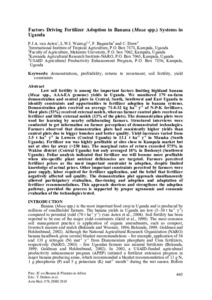| dc.contributor.author | Asten, Piet J.A. van |
| dc.contributor.author | Wairegi, L.W.I. |
| dc.contributor.author | Bagamba, F. |
| dc.contributor.author | Drew, C. |
| dc.date.accessioned | 2019-12-04T11:14:02Z |
| dc.date.available | 2019-12-04T11:14:02Z |
| dc.date.issued | 2010 |
| dc.identifier.citation | Van Asten, P., Wairegi, L.W.I., Bagamba,F. & Drew, C. (2010). Factors driving fertilizer adoption in banana (Musa spp.) systems in Uganda. In IV International Symposium on Banana: International Conference on Banana and Plantain in Africa. Acta Horticulturae, 879, 465-477. |
| dc.identifier.issn | 0567-7572 |
| dc.identifier.uri | https://hdl.handle.net/20.500.12478/2615 |
| dc.description.abstract | Low soil fertility is among the important factors limiting highland banana (Musa spp., AAA-EA genome) yields in Uganda. We monitored 179 on-farm demonstration and control plots in Central, South, Southwest and East Uganda to identify constraints and opportunities to fertilizer adoption in banana systems. Demonstration plots received on average 71-8-32 kg ha-1 y-1 of N-P-K fertilizers. Most plots (53%) received external mulch, whereas farmer control plots received no fertilizer and little external mulch (13% of the plots). The demonstration plots were used for learning by nearby collaborating farmers. Structured interviews were conducted to get information on farmer perceptions of demonstrated technologies. Farmers observed that demonstration plots had consistently higher yields than control plots due to bigger bunches and better quality. Yield increases varied from 3.5 t ha-1 y-1 in Luwero (Central Uganda) to 13.1 t ha-1 y-1 in Masaka (South Uganda). Fertilizer use was highly profitable at sites close to Kampala market but not at sites far away (>250 km). The marginal rates of return exceeded 575% in Wakiso district (Central Uganda) but only averaged 10% in Bushenyi (Southwest Uganda). Foliar analysis indicated that fertilizer use will become more profitable when site-specific plant nutrient deficiencies are targeted. Farmers perceived fertilizer prices as the most important constraint to adoption, despite limited knowledge of actual prices. Other important constraints perceived by farmers were poor supply, labor required for fertilizer application, and the belief that fertilizer negatively affected soil quality. The demonstration plot approach simultaneously allowed participatory evaluation, fine-tuning and adoption and adaptation of fertilizer recommendations. This approach shortens and strengthens the adoption pathway, provided the process is supported by proper agronomic and economic evaluation of the technologies tested. |
| dc.description.sponsorship | United States Agency for International Development |
| dc.description.sponsorship | Agricultural Productivity Enhancement Program |
| dc.format.extent | 465-477 |
| dc.language.iso | en |
| dc.subject | Demonstrations |
| dc.subject | Profitability |
| dc.subject | Returns To Investment |
| dc.subject | Soil Fertility |
| dc.subject | Yield Constraints |
| dc.title | Factors driving fertilizer adoption in banana (Musa spp.) systems in Uganda |
| dc.type | Journal Article |
| dc.description.version | Peer Review |
| cg.contributor.affiliation | International Institute of Tropical Agriculture |
| cg.contributor.affiliation | Makerere University |
| cg.contributor.affiliation | Kawanda Agricultural Research Institute, Uganda |
| cg.contributor.affiliation | United States Agency for International Development |
| cg.coverage.region | Africa |
| cg.coverage.region | East Africa |
| cg.coverage.country | Uganda |
| cg.authorship.types | CGIAR and developing country institute |
| cg.iitasubject | Soil Fertility |
| cg.iitasubject | Integrated Soil Fertility Management |
| cg.iitasubject | Markets |
| cg.iitasubject | Impact Assessment |
| cg.journal | Acta Horticulturae |
| cg.howpublished | Formally Published |
| cg.accessibilitystatus | Limited Access |
| local.dspaceid | 93419 |
| cg.targetaudience | Scientists |

